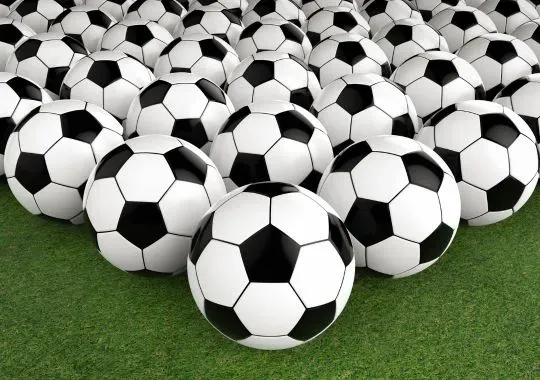Soccer, known as the beautiful game, has captivated millions of hearts around the world for decades. Whether you're a professional athlete or an amateur enthusiast, the right soccer ball can make all the difference in your performance. But have you ever wondered what is the most expensive soccer ball that you can play?
As Amazon affiliates we may earn a commission if you purchase a product at no cost to you.
The Significance of a Ball
In the world of soccer, the significance of a ball extends beyond being just a spherical object kicked around the field. It serves as the fundamental tool of the game, dictating playstyle, performance, and even strategy. While some may perceive all soccer balls as identical, they actually vary significantly in materials, construction, and price. These differences directly impact factors such as flight trajectory, touch, durability, and overall playability.
Understanding the nuances between different soccer balls is essential for players and enthusiasts alike. From casual recreational matches to high-stakes professional games, selecting the right ball can profoundly influence the outcome and enjoyment of the sport. Factors such as playing surface, weather conditions, player skill level, and intended use must all be considered when choosing the appropriate ball.
Nike Flight Ball: The Pinnacle of Performance
Nike's Flight Ball stands out as a pinnacle of soccer ball technology, representing the epitome of performance and innovation. Priced at $160, this top-tier ball incorporates cutting-edge features designed to elevate gameplay to new heights. Its AeroSculpt grooves optimize aerodynamics, ensuring unparalleled stability and accuracy during flight.
Constructed with four panels and utilizing fusion welding techniques, the Nike Flight Ball offers exceptional consistency and durability. These design elements contribute to a seamless playing experience, allowing players to focus on their technique without being hindered by inconsistencies in ball flight or bounce.
Moreover, the Flight Ball has earned FIFA Quality Pro certification, signifying its suitability for use in professional matches at the highest levels of competition. This endorsement underscores the ball's exceptional performance characteristics, making it the preferred choice for elite players seeking uncompromising quality and reliability on the field.
The Nike Flight Ball represents the pinnacle of soccer ball engineering, combining advanced technology, superior construction, and uncompromising performance. Whether used in professional matches or recreational games, it embodies Nike's commitment to excellence and innovation in the world of soccer.

Nike Club Elite Ball: Mid-Range Excellence
The Nike Club Elite Ball stands out as a mid-range option for soccer players looking for a balance between quality and affordability. Priced at $60, it offers several features typically found in higher-end soccer balls. The inclusion of AeroSculpt grooves enhances aerodynamics, contributing to improved flight stability and accuracy during gameplay. Additionally, the ball boasts FIFA Quality certification, ensuring its suitability for use in matches at various levels of competition.
Constructed with hand-stitched panels, the Nike Club Elite Ball prioritizes durability, making it suitable for prolonged use on different playing surfaces. While it may not match the premium quality of more expensive models, it provides a satisfactory level of performance for most players. However, some users have reported issues with the overall feel and responsiveness of the ball compared to higher-end alternatives.
Overall, the Nike Club Elite Ball offers a compelling option for individuals seeking a mid-range soccer ball that delivers a balance of performance and affordability. Its combination of advanced features and durable construction makes it a popular choice among players who prioritize value for money.
Nike Strike Ball: Affordable and Accessible
The Nike Strike Ball caters to budget-conscious consumers seeking an affordable entry-level option for casual gameplay. Priced at $30, it offers a cost-effective solution for individuals looking to enjoy soccer without investing in high-priced equipment. While the Nike Strike Ball incorporates some features such as AeroSculpt grooves, its overall construction and material quality are noticeably inferior compared to higher-end models.
Despite its lower price point, the Nike Strike Ball still provides decent performance for recreational play. However, due to its lower-quality materials and construction, it may not withstand the rigors of competitive matches or extended use on rough surfaces. Nonetheless, for casual players and beginners, it represents a suitable option to kickstart their soccer journey without breaking the bank.
The Nike Strike Ball offers affordability and accessibility, making it an attractive choice for individuals entering the world of soccer or seeking a budget-friendly option for leisurely games.
Nike Pitch Ball: Budget-Friendly Basics
Completing Nike's range of soccer balls is the Nike Pitch Ball, priced affordably at $20. Designed with simplicity in mind, it features a smooth surface and basic construction. While lacking the advanced technologies and features found in higher-end models like the Flight Ball, the Pitch Ball serves its purpose well for recreational use. Its modest price point makes it accessible to a wide range of players, particularly those on a budget or beginners who are just starting their soccer journey.
However, due to its basic design and construction, the Pitch Ball falls short in terms of both performance and durability compared to its more expensive counterparts. Players may notice reduced ball control, flight stability, and overall playability when using the Pitch Ball, especially in more demanding game situations. Despite these limitations, it remains a popular choice for casual games, training sessions, and backyard matches where performance requirements are not as stringent.

Choosing the Right Ball
Selecting the ideal soccer ball involves considering various factors such as budget, playing level, and personal preferences. While the Nike Flight Ball offers top-tier performance and cutting-edge technology, it may not be necessary or practical for every player. Understanding your individual needs and requirements is crucial in making the right decision.
For those seeking unparalleled performance and willing to invest in the best, the Flight Ball is the obvious choice. However, for budget-conscious players or those prioritizing simplicity and accessibility, options like the Pitch Ball provide a viable alternative. Ultimately, the key is to choose a ball that aligns with your goals, preferences, and budget, ensuring an enjoyable and fulfilling soccer experience.
Recommended Article

Frequently Asked Questions FAQs
What makes a soccer ball expensive?
Expensive soccer balls often feature high-quality materials like genuine leather, advanced construction techniques, and innovative design elements. The use of luxury materials, exquisite craftsmanship, limited edition releases, and associations with renowned players contribute to their higher price tags.
Are expensive soccer balls worth the investment?
It depends on your playing level, preferences, and budget. Expensive soccer balls offer superior performance, enhanced ball control, and exceptional durability. If you're a professional player or passionate about the sport, investing in a high-end ball can elevate your game. However, recreational players or beginners may find more affordable options sufficient for their needs.
Can expensive soccer balls improve my skills?
While expensive soccer balls provide advanced features and superior materials, their impact on skill improvement may vary. These balls can enhance ball control, touch, and responsiveness, allowing players to perform at their best. However, skill development primarily relies on practice, technique, and individual effort.
Conclusion
What is the most expensive soccer ball that you can play? When it comes to choosing a soccer ball, it's essential to make an informed decision by balancing price and performance. While luxury and high-end soccer balls offer superior craftsmanship and advanced features, they may not always be necessary for every player or budget.










